Majestic wild horses are trampling Mono Lake's otherworldly landscape. The feds plan a roundup
Several dozen horses calmly graze along the shores of Mono Lake, a sparkling saline expanse spread out before the jagged Sierra Nevada mountains. The September sun is blazing. A pair of brown horses come up side by side and stare intensely at an approaching visitor.These wild equines soon may disappear from beside the ancient lake. The prospect is stirring emotional disagreement over the future of the herd, which has surged to more than three times what federal officials say the land can support.“These horses deserve a place to roam and be free, but around Mono Lake is not the place,” said Bartshe Miller of the Mono Lake Committee, an environmental nonprofit. Bartshe Miller, Eastern Sierra policy director for the Mono Lake Committee, looks out onto the landscape at Warm Springs, a remote area on the east side of Mono Lake. Earlier this year, the U.S. Forest Service and Bureau of Land Management approved a plan to round up and remove hundreds of wild horses roaming beyond the roughly 200,000 acres designated for them along the California and Nevada border. No date has been set, but it could be as soon as this fall.It would be a relief for some. Environmentalists say the horses are degrading the otherworldly landscape at Mono Lake, including bird habitat and its famed tufa — textured rock columns that would look at home on Mars. Ranchers say the animals are gobbling down plants needed to sustain their cattle. Federal officials highlight the safety hazard posed by horses that have wandered onto highways.Others see the move as a travesty. One method to oust the horses would use helicopters to drive them into a trap, which animal welfare groups say creates dangerous, even deadly, situations for horses. A pending federal bill would ban the practice.Local tribes and nonprofits have partnered to fight the roundup plan, arguing that the Indigenous community should be tapped to manage the animals that roam their ancestral lands. A separate group of plaintiffs has sued the government, claiming it’s reneging on its duty to protect the horses. A group of horses roams near the community of Benton, Calif., not far from the Nevada border. Ronda Kauk, of the Mono Lake Kootzaduka’a tribe, stands near wild horses. “We’re all living spirits,” said Ronda Kauk, a member of the Mono Lake Kootzaduka’a tribe. “And it’s sad that people just don’t care about another living thing because they think it doesn’t belong there.”Unseen evolutionFor 36 years, Dave Marquart was part of a small team that monitored wetlands rimming Mono Lake, places so inaccessible even four-wheel drives can get stuck. Flung out far on the landscape, only wildlife could enjoy them. The area was a major nesting site for yellow-headed black birds, red-winged black birds, marsh wrens, soras and Virginia rails.“There weren’t a lot of people that saw the transition that I saw, from healthy wetlands to completely trampled and devastated wetlands,” said Marquart, who was an interpretive naturalist for the Mono Lake Tufa State Natural Reserve until he retired in 2019. “It was quite a drastic change.”Marquart recalled a time when he’d encounter fewer than 50 horses. They’d bolt when they saw his vehicle coming. That fear faded and their ranks grew. Over time, he said, they stamped ponds and urinated and defecated in the water. The birds stopped showing up. Bartshe Miller holds grass he said was pulled up by the roots by wild horses roaming near Mono Lake. According to Miller, horses started arriving near the lake around 2015. Before retiring, Marquart said, he helped organize a field trip involving the Forest Service, BLM and State Parks to showcase the impacts.“Everybody saw that it was an issue and felt that something needed to be done,” he said.Today, sizable mounds of horse manure dot Warm Springs, a remote area along the eastern edge of Mono Lake that Marquart had raised the alarm about during his tenure. White bones of fallen equines rest in the alkaline meadows. Chestnut fur gleamed on a hoof attached to a leg bone.Miller, the Mono Lake Committee’s Eastern Sierra policy director, and Geoff McQuilkin, its executive director, led the way to a burbling spring rimmed by innumerable hoof prints. Surrounding vegetation was nibbled to nubs. Wildlife compete for the limited water here. The bleached bones of a wild horse lie in vegetation near the shores of Mono Lake. “The birds that would have a safe haven in that spring or be hidden away from raptors and predators overhead don’t have that opportunity anymore,” McQuilkin said.The pair first remembered the horses showing up in remote areas around the lake in 2015, as the state was gripped by drought. By 2021, as they pushed west, they landed at South Tufa, where tourists congregate to gaze at the limestone columns. In the spring of 2023, horse carcasses emerged along the shores of South Tufa and nearby Navy Beach as the snow from a winter of biblical proportions melted.“The recent deaths of these horses provide further evidence that the size of this herd cannot be supported by the landscape which they are expanding onto,” Lisa Cox, a spokesperson for the Inyo National Forest, said at the time.“They’re medicine.” Rana Saulque, vice chairwoman of the Utu Utu Gwaitu Paiute tribe, walks near a natural spring in an area where wild horses gather near the community of Benton, Calif. On a pleasantly cool day in September, Rana Saulque stared transfixed at a group of roughly 50 wild horses in the River Spring Lakes Ecological Reserve, not far from her tribe’s reservation near the town of Benton. Saulque, vice chairwoman for the Utu Utu Gwaitu Paiute tribe, draws a parallel between ousting the horses and the historic persecution of her people by the government. “They’re going to run them down with helicopters and genocide them, just like they ran down us,” she said through tears. A striking cremello horse stood out from the rest — a beloved subject for photographers who sojourn here. A brown foal with a white stripe on its muzzle teetered on toothpick legs. Several babies hugged close to their moms.Mostly, the horses peacefully graze, but two rear up momentarily. “That’s horsing around,” Saulque said. Then they begin galloping and suddenly they look powerful and sleek. Epic, like a poster for a classic western film. Dozens of wild horses graze on the River Spring Lakes Ecological Reserve. “They’re so magical,” the vice chairwoman said. “They’re medicine for people.”Federal officials stress that they have precautions in place to ensure safety during helicopter roundups. That includes avoiding peak foaling periods and hot weather that would stress the horses.The Utu Utu Gwaitu Paiute are among a coalition that wants to pause the planned roundups for two years and ultimately secure land back to set aside a sanctuary for the horses to roam. As envisioned, local tribes would help manage the herd, including darting horses with a birth control vaccine to limit population growth. Horses could be put to work at pack stations, equine therapy and rodeo schools for kids, the group says.The proposal could also help revive horse culture that runs deep in the tribal communities, Saulque said. Jim Walker, her great-great-grandfather and a respected medicine man, rode mustangs all the way to Florida, visiting tribes along the way to exchange medicine and horses. Maya Jamal Kasberg, founder of nonprofit Made by Mother Earth, is part of the coalition that wants to scrap the current plan to round up Montgomery Pass horses. Kauk’s tribe historically rode the horses from Lee Vining into Yosemite to gather basket-making materials, among other activities. Mustangs were tapped for Native American rodeos and relay races, she added.According to the coalition that includes the nonprofit American Wild Horse Conservation, the feds and groups like the Mono Lake Committee have the science all wrong. The herbivores chomp down invasive cheatgrass that poses wildfire risk, and their poop — maligned by many — actually spreads native seeds, they say. Wild and free — for nowAt the heart of the emotional battle playing out in the Eastern Sierra is the Montgomery Pass wild horse herd. According to the U.S. Forest Service, its origin is unknown. But there’s speculation that it’s linked to mustang drives between the Owens Valley and Nevada.A 1971 law declared wild horses and burros “living symbols of the historic and pioneer spirit of the West,” and made it illegal to harass, capture or kill them on public lands. But the Forest Service and BLM, which became responsible for managing them, can remove “excess animals” to preserve the health of the range.The way this often plays out is that horses are rounded up and offered for adoption or sale. Those that aren’t taken in by a private owner are shipped to pastures where they often live out their remaining days. A census last year found that there are now about 700 horses in the Montgomery Pass herd. Federal officials designated the Montgomery Pass Wild Horse Territory, a remote area spanning sagebrush steppe and pinyon pine forest east of Mono Lake. They say the land can sustainably support 138 to 230 horses. As of last year, nearly 700 were documented in an aerial survey, with most ranging outside the territory, according to the agencies. Now under a plan approved in March, up to 500 horses could be ousted, with the Forest Service leading the effort and BLM assisting.Both agencies declined requests for interviews for this story, citing pending litigation. In August, a documentary filmmaker, primary care physician and wildlife ecologist sued the government authorities overseeing the agencies, claiming the roundups will decimate the herd to the point where long-term survival is unlikely.“This case represents yet another attempt by the agencies to evade their statutory duties to protect, preserve and manage the herd,” the suit reads.The government has agreed not to round up horses before Oct. 20, according to court documents.When multiple uses collide Rancher Leslie Hunewill looks at calves and their moms at her family’s historic ranch in Bridgeport. Leslie Hunewill’s cattle ranching family sees quite a bit of “horse activity” on grazing lands in an area called the Mono Sand Flats, to the east and north of the lake. Since purchasing the right to use the public land, her outfit has been able to graze there for only about five weeks in the last two years — and not consecutively. The culprit? “A huge number of horses,” she said.“Our cattle have not been out there,” she said. “There’s nothing for them to eat.” Cows aren’t allowed on the roughly 50,000-acre expanse during the growing season. But the horses, facing no fences, go for what’s green and pushing up, she said.“It doesn’t make sense for us to overuse or overgraze the land when we need to come back to it,” she said. “So when we are doing our part to manage the portion of it that we can, which is, say, our use of the cattle on that land, that’s all well and good. But who is taking charge of the horses and saying, this is too heavy use?” The Hunewills, who have deep roots in the Eastern Sierra, operate a guest ranch in Bridgeport. The law directs agencies to manage horse populations to maintain a “thriving natural ecological balance.” BLM and the Forest Service have to consider mustangs alongside grazing, wildlife and what’s good for the land. Some say the agencies have kicked the can down the road on management of the Montgomery Pass herd.Hunewill’s family has deep roots in the Eastern Sierra. Her great-great-great-grandfather came to California in the 1860s as a gold miner. He struck it rich, and got into the lumber business. When that stopped paying out, he used his oxen to feed the town of Bodie. Her family is still in the beef business, with the meat generally staying on the West Coast.They employ quite a few mustangs at their guest ranch operation in the town of Bridgeport, including Jethro, a friendly brown fella with a splash of white on his forehead. They’re hardy horses, and can be enlisted as pack animals high up in the mountains. Some don’t need shoes because of their “great feet.” But their robustness means “everybody’s already got their mustang,” she said, stymieing the prospect of mass adoptions.Shifting dynamicsWild horse populations can increase as much as 20% a year. Montgomery Pass horses used to summer in the high country and were once kept in check by mountain lions that preyed on foals, according to John Turner, a professor at the University of Toledo College of Medicine, who studied the herd for decades.That changed around 2008 or 2009, when the horses began lingering at lower elevations, where the open country makes it difficult for lions to hunt.The herd’s population surged. Turner sees the government’s current system of rounding up horses and holding them as unsustainable. And costly.“The gathers are successful at that time, but the reproductive rate of the animals is greater than the capacity to remove them,” he said.
Federal officials plan to round up wild horses roaming the Eastern Sierra, citing hazards and damage. But local tribes and others seek a different outcome.
Several dozen horses calmly graze along the shores of Mono Lake, a sparkling saline expanse spread out before the jagged Sierra Nevada mountains. The September sun is blazing. A pair of brown horses come up side by side and stare intensely at an approaching visitor.
These wild equines soon may disappear from beside the ancient lake. The prospect is stirring emotional disagreement over the future of the herd, which has surged to more than three times what federal officials say the land can support.
“These horses deserve a place to roam and be free, but around Mono Lake is not the place,” said Bartshe Miller of the Mono Lake Committee, an environmental nonprofit.

Bartshe Miller, Eastern Sierra policy director for the Mono Lake Committee, looks out onto the landscape at Warm Springs, a remote area on the east side of Mono Lake.
Earlier this year, the U.S. Forest Service and Bureau of Land Management approved a plan to round up and remove hundreds of wild horses roaming beyond the roughly 200,000 acres designated for them along the California and Nevada border. No date has been set, but it could be as soon as this fall.
It would be a relief for some. Environmentalists say the horses are degrading the otherworldly landscape at Mono Lake, including bird habitat and its famed tufa — textured rock columns that would look at home on Mars. Ranchers say the animals are gobbling down plants needed to sustain their cattle. Federal officials highlight the safety hazard posed by horses that have wandered onto highways.
Others see the move as a travesty. One method to oust the horses would use helicopters to drive them into a trap, which animal welfare groups say creates dangerous, even deadly, situations for horses. A pending federal bill would ban the practice.
Local tribes and nonprofits have partnered to fight the roundup plan, arguing that the Indigenous community should be tapped to manage the animals that roam their ancestral lands. A separate group of plaintiffs has sued the government, claiming it’s reneging on its duty to protect the horses.
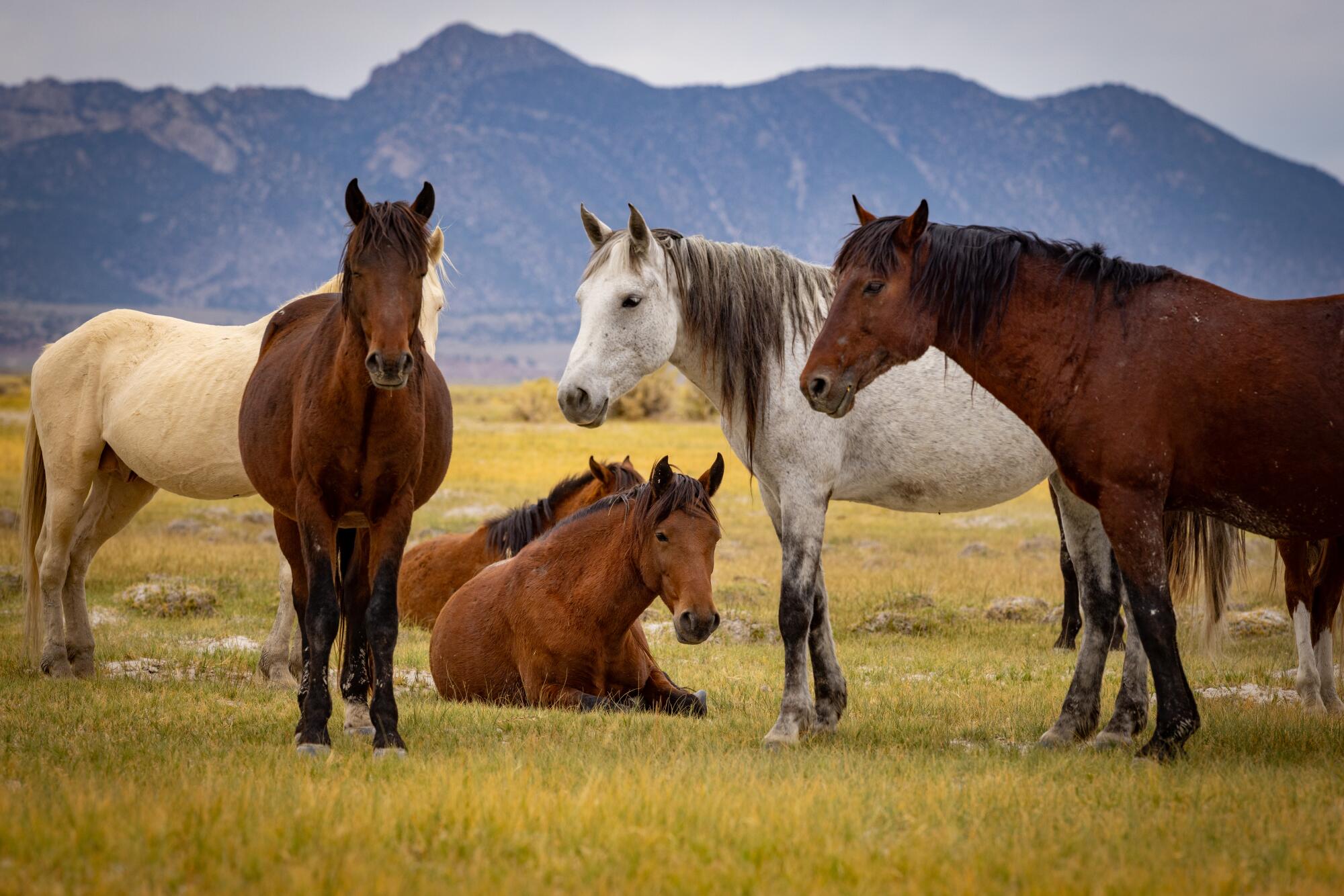
A group of horses roams near the community of Benton, Calif., not far from the Nevada border.
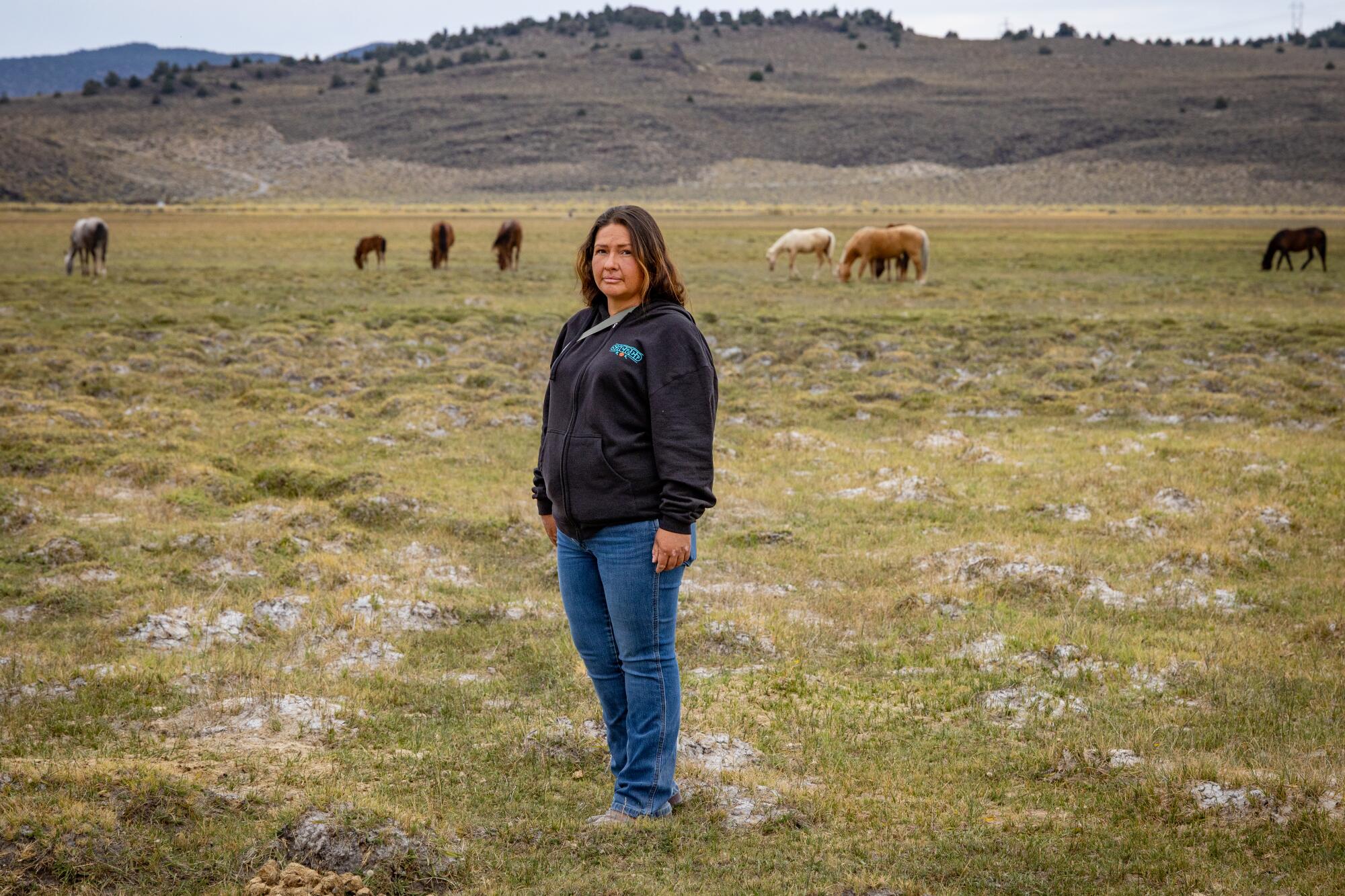
Ronda Kauk, of the Mono Lake Kootzaduka’a tribe, stands near wild horses.
“We’re all living spirits,” said Ronda Kauk, a member of the Mono Lake Kootzaduka’a tribe. “And it’s sad that people just don’t care about another living thing because they think it doesn’t belong there.”
Unseen evolution
For 36 years, Dave Marquart was part of a small team that monitored wetlands rimming Mono Lake, places so inaccessible even four-wheel drives can get stuck. Flung out far on the landscape, only wildlife could enjoy them. The area was a major nesting site for yellow-headed black birds, red-winged black birds, marsh wrens, soras and Virginia rails.
“There weren’t a lot of people that saw the transition that I saw, from healthy wetlands to completely trampled and devastated wetlands,” said Marquart, who was an interpretive naturalist for the Mono Lake Tufa State Natural Reserve until he retired in 2019. “It was quite a drastic change.”
Marquart recalled a time when he’d encounter fewer than 50 horses. They’d bolt when they saw his vehicle coming. That fear faded and their ranks grew. Over time, he said, they stamped ponds and urinated and defecated in the water. The birds stopped showing up.

Bartshe Miller holds grass he said was pulled up by the roots by wild horses roaming near Mono Lake. According to Miller, horses started arriving near the lake around 2015.
Before retiring, Marquart said, he helped organize a field trip involving the Forest Service, BLM and State Parks to showcase the impacts.
“Everybody saw that it was an issue and felt that something needed to be done,” he said.
Today, sizable mounds of horse manure dot Warm Springs, a remote area along the eastern edge of Mono Lake that Marquart had raised the alarm about during his tenure. White bones of fallen equines rest in the alkaline meadows. Chestnut fur gleamed on a hoof attached to a leg bone.
Miller, the Mono Lake Committee’s Eastern Sierra policy director, and Geoff McQuilkin, its executive director, led the way to a burbling spring rimmed by innumerable hoof prints. Surrounding vegetation was nibbled to nubs. Wildlife compete for the limited water here.
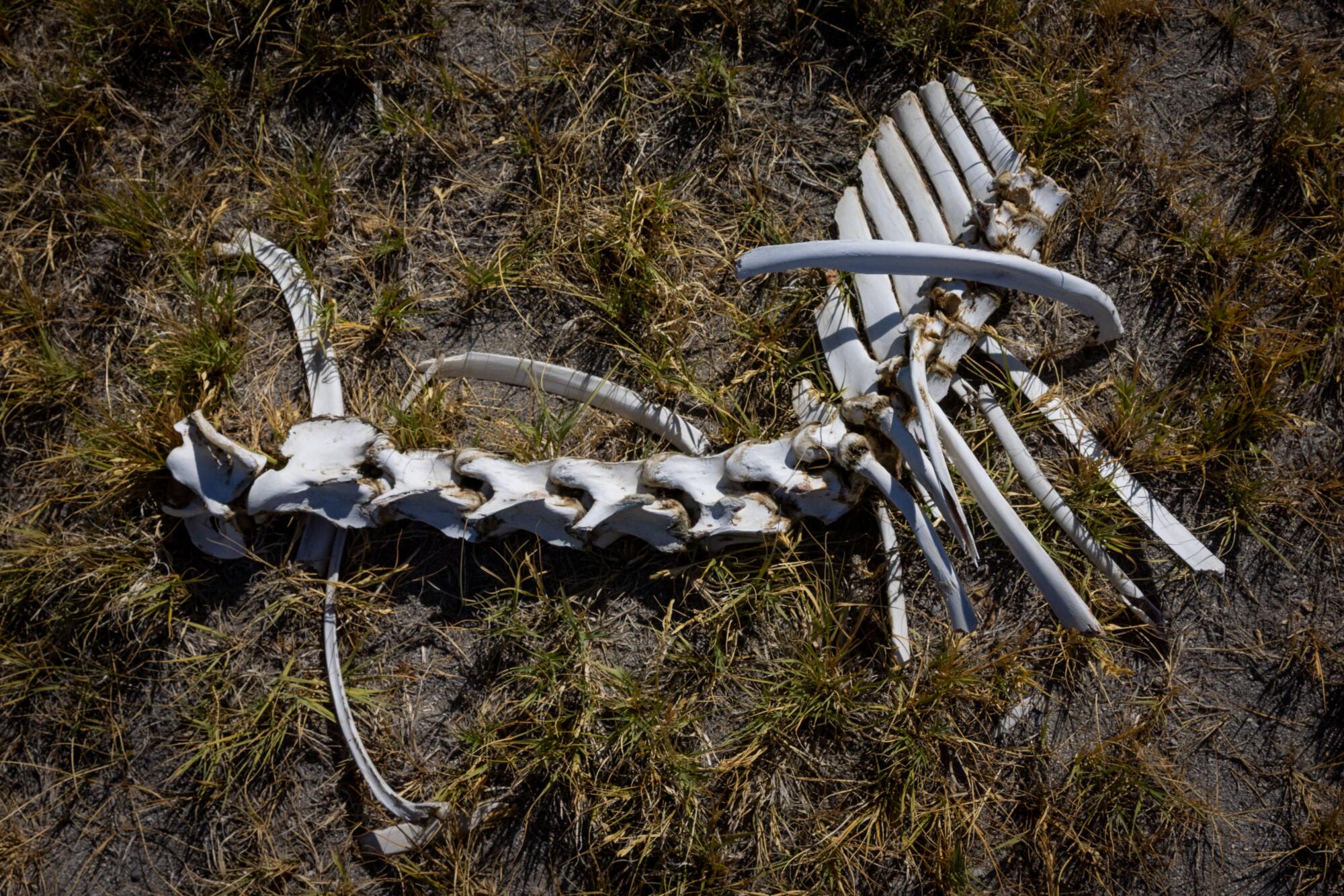
The bleached bones of a wild horse lie in vegetation near the shores of Mono Lake.
“The birds that would have a safe haven in that spring or be hidden away from raptors and predators overhead don’t have that opportunity anymore,” McQuilkin said.
The pair first remembered the horses showing up in remote areas around the lake in 2015, as the state was gripped by drought. By 2021, as they pushed west, they landed at South Tufa, where tourists congregate to gaze at the limestone columns. In the spring of 2023, horse carcasses emerged along the shores of South Tufa and nearby Navy Beach as the snow from a winter of biblical proportions melted.
“The recent deaths of these horses provide further evidence that the size of this herd cannot be supported by the landscape which they are expanding onto,” Lisa Cox, a spokesperson for the Inyo National Forest, said at the time.
“They’re medicine.”
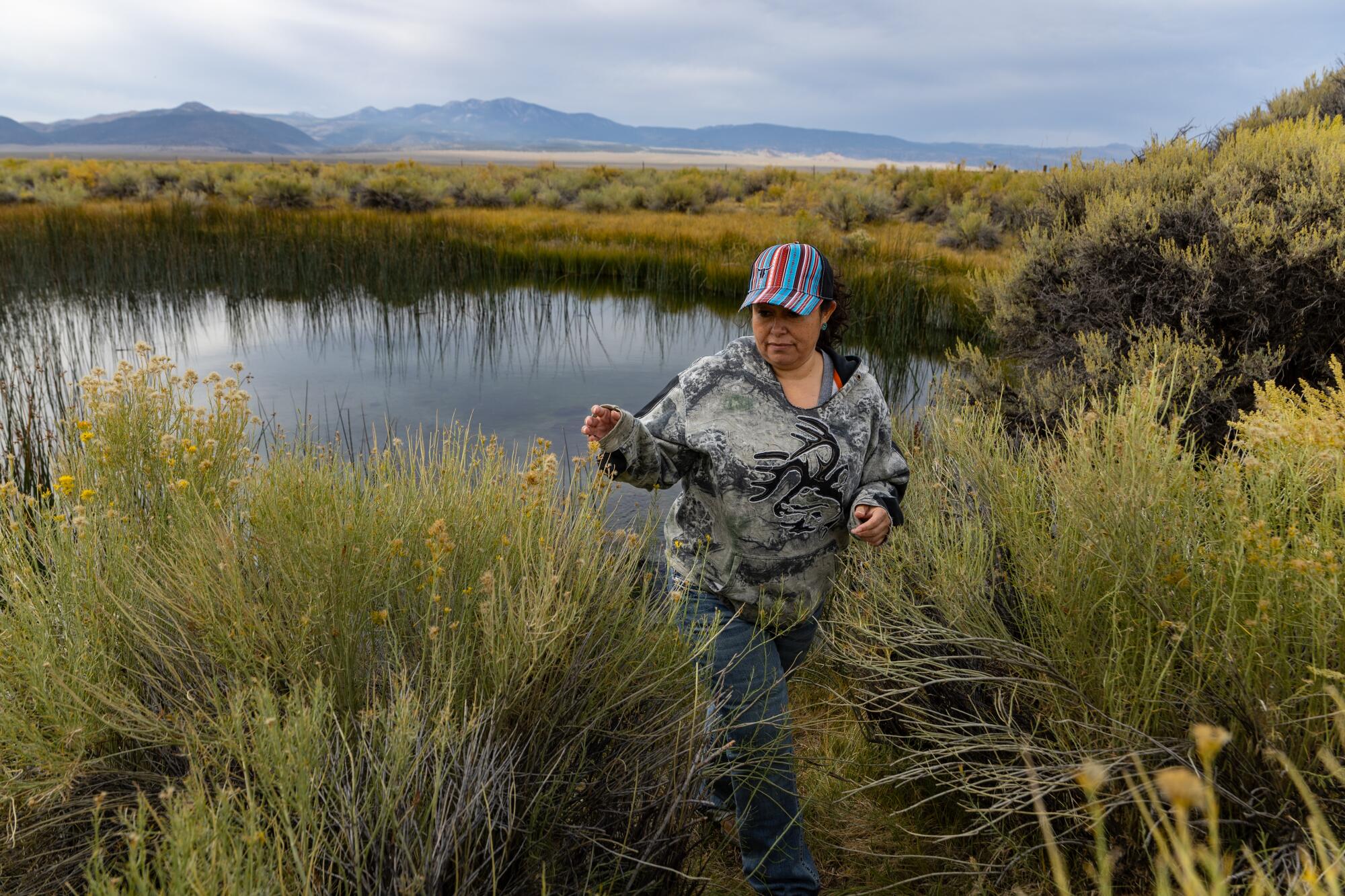
Rana Saulque, vice chairwoman of the Utu Utu Gwaitu Paiute tribe, walks near a natural spring in an area where wild horses gather near the community of Benton, Calif.
On a pleasantly cool day in September, Rana Saulque stared transfixed at a group of roughly 50 wild horses in the River Spring Lakes Ecological Reserve, not far from her tribe’s reservation near the town of Benton.
Saulque, vice chairwoman for the Utu Utu Gwaitu Paiute tribe, draws a parallel between ousting the horses and the historic persecution of her people by the government.
“They’re going to run them down with helicopters and genocide them, just like they ran down us,” she said through tears.
A striking cremello horse stood out from the rest — a beloved subject for photographers who sojourn here. A brown foal with a white stripe on its muzzle teetered on toothpick legs. Several babies hugged close to their moms.
Mostly, the horses peacefully graze, but two rear up momentarily. “That’s horsing around,” Saulque said. Then they begin galloping and suddenly they look powerful and sleek. Epic, like a poster for a classic western film.
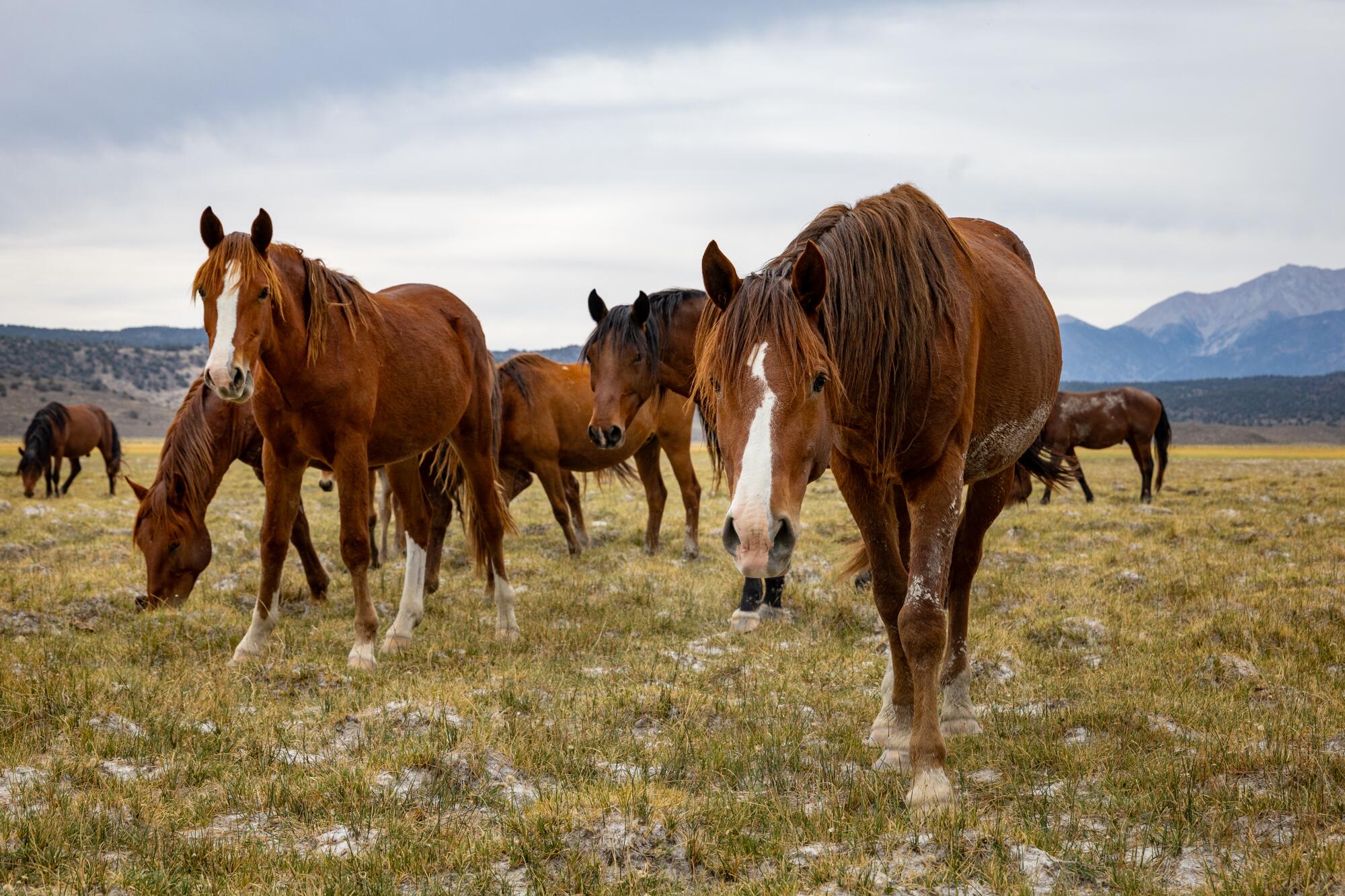
Dozens of wild horses graze on the River Spring Lakes Ecological Reserve.
“They’re so magical,” the vice chairwoman said. “They’re medicine for people.”
Federal officials stress that they have precautions in place to ensure safety during helicopter roundups. That includes avoiding peak foaling periods and hot weather that would stress the horses.
The Utu Utu Gwaitu Paiute are among a coalition that wants to pause the planned roundups for two years and ultimately secure land back to set aside a sanctuary for the horses to roam. As envisioned, local tribes would help manage the herd, including darting horses with a birth control vaccine to limit population growth. Horses could be put to work at pack stations, equine therapy and rodeo schools for kids, the group says.
The proposal could also help revive horse culture that runs deep in the tribal communities, Saulque said. Jim Walker, her great-great-grandfather and a respected medicine man, rode mustangs all the way to Florida, visiting tribes along the way to exchange medicine and horses.
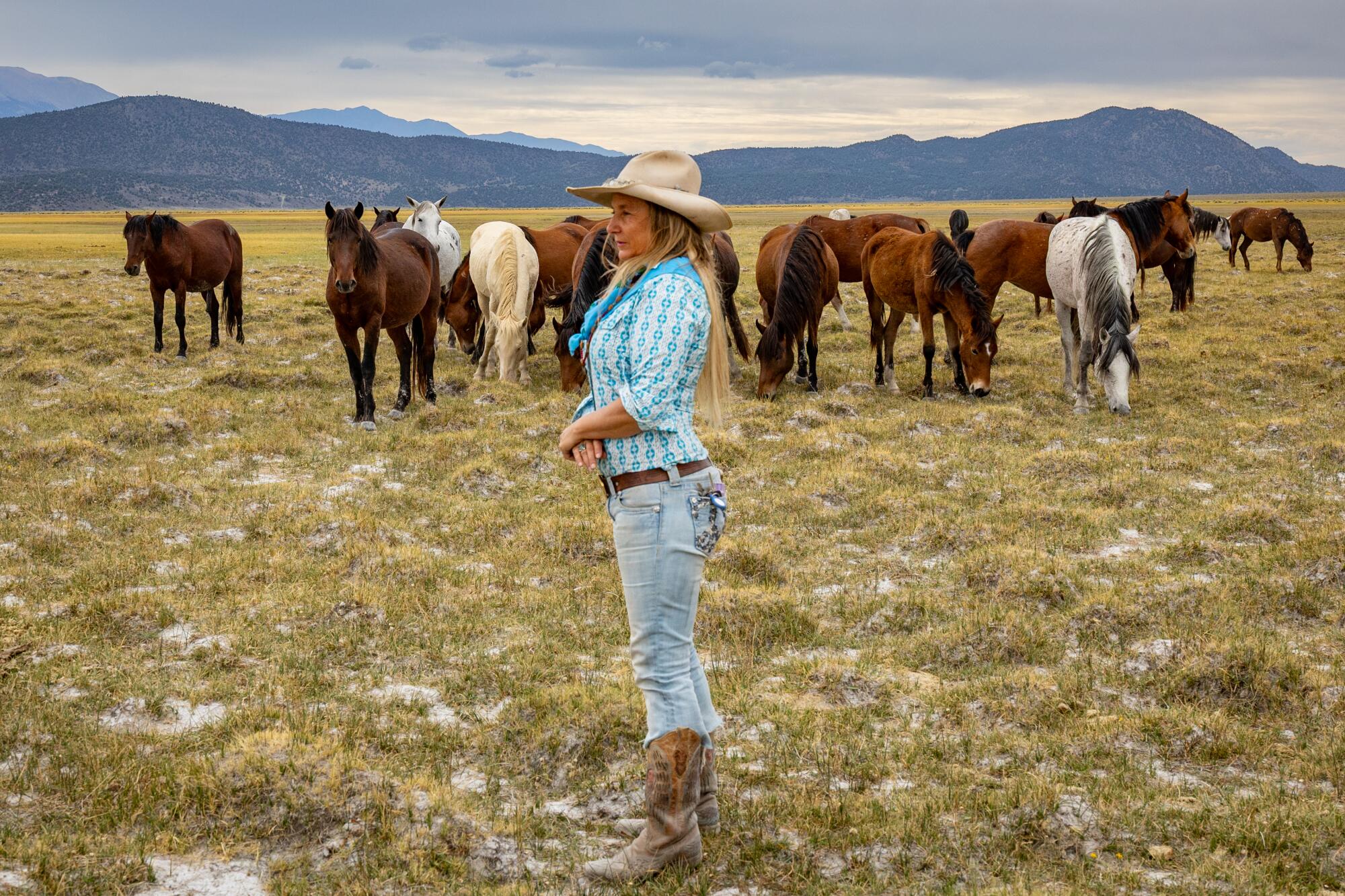
Maya Jamal Kasberg, founder of nonprofit Made by Mother Earth, is part of the coalition that wants to scrap the current plan to round up Montgomery Pass horses.
Kauk’s tribe historically rode the horses from Lee Vining into Yosemite to gather basket-making materials, among other activities. Mustangs were tapped for Native American rodeos and relay races, she added.
According to the coalition that includes the nonprofit American Wild Horse Conservation, the feds and groups like the Mono Lake Committee have the science all wrong. The herbivores chomp down invasive cheatgrass that poses wildfire risk, and their poop — maligned by many — actually spreads native seeds, they say.
Wild and free — for now
At the heart of the emotional battle playing out in the Eastern Sierra is the Montgomery Pass wild horse herd. According to the U.S. Forest Service, its origin is unknown. But there’s speculation that it’s linked to mustang drives between the Owens Valley and Nevada.
A 1971 law declared wild horses and burros “living symbols of the historic and pioneer spirit of the West,” and made it illegal to harass, capture or kill them on public lands. But the Forest Service and BLM, which became responsible for managing them, can remove “excess animals” to preserve the health of the range.
The way this often plays out is that horses are rounded up and offered for adoption or sale. Those that aren’t taken in by a private owner are shipped to pastures where they often live out their remaining days.

A census last year found that there are now about 700 horses in the Montgomery Pass herd.
Federal officials designated the Montgomery Pass Wild Horse Territory, a remote area spanning sagebrush steppe and pinyon pine forest east of Mono Lake. They say the land can sustainably support 138 to 230 horses.
As of last year, nearly 700 were documented in an aerial survey, with most ranging outside the territory, according to the agencies.
Now under a plan approved in March, up to 500 horses could be ousted, with the Forest Service leading the effort and BLM assisting.
Both agencies declined requests for interviews for this story, citing pending litigation. In August, a documentary filmmaker, primary care physician and wildlife ecologist sued the government authorities overseeing the agencies, claiming the roundups will decimate the herd to the point where long-term survival is unlikely.
“This case represents yet another attempt by the agencies to evade their statutory duties to protect, preserve and manage the herd,” the suit reads.
The government has agreed not to round up horses before Oct. 20, according to court documents.
When multiple uses collide
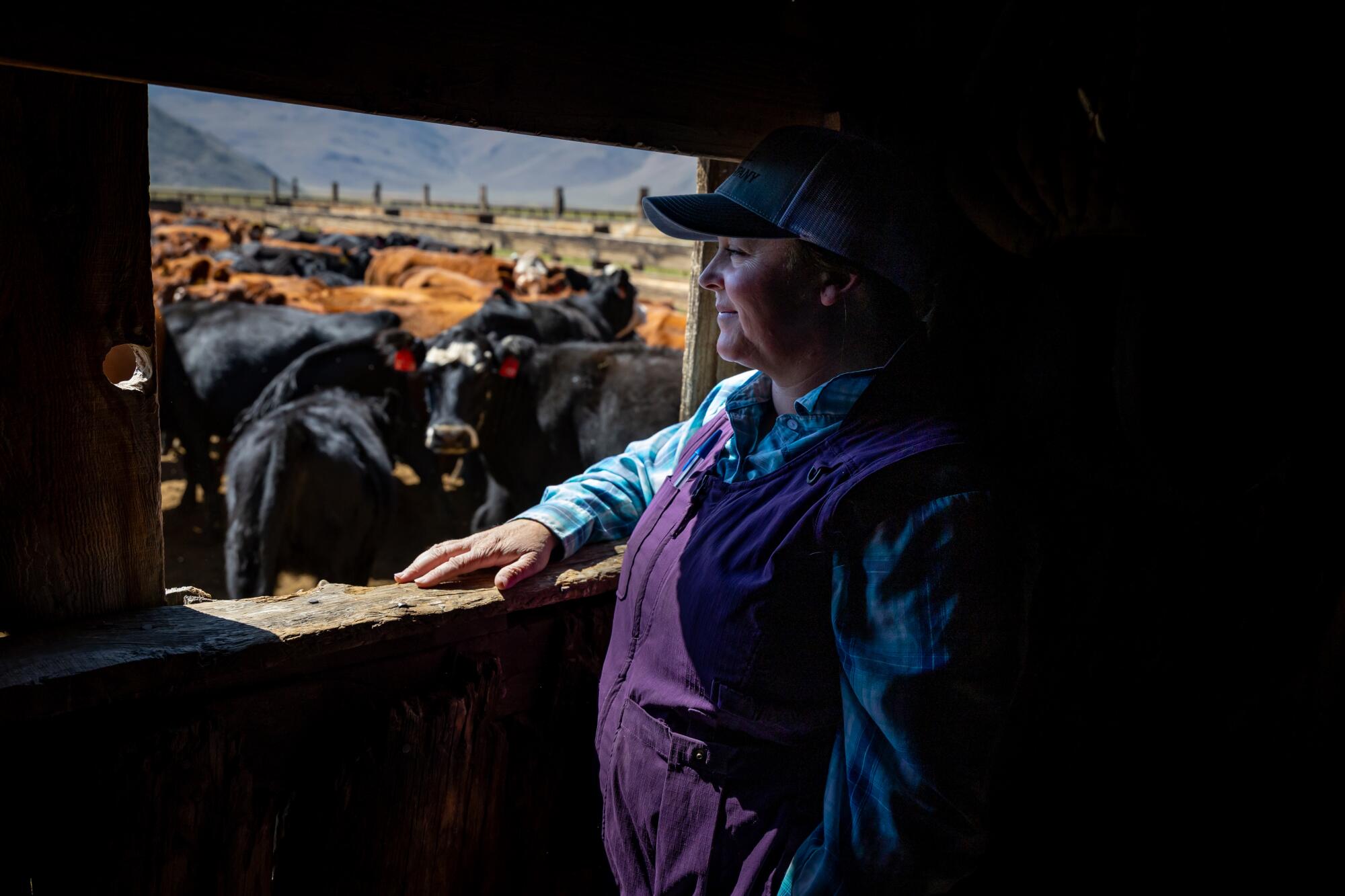
Rancher Leslie Hunewill looks at calves and their moms at her family’s historic ranch in Bridgeport.
Leslie Hunewill’s cattle ranching family sees quite a bit of “horse activity” on grazing lands in an area called the Mono Sand Flats, to the east and north of the lake. Since purchasing the right to use the public land, her outfit has been able to graze there for only about five weeks in the last two years — and not consecutively. The culprit? “A huge number of horses,” she said.
“Our cattle have not been out there,” she said. “There’s nothing for them to eat.”
Cows aren’t allowed on the roughly 50,000-acre expanse during the growing season. But the horses, facing no fences, go for what’s green and pushing up, she said.
“It doesn’t make sense for us to overuse or overgraze the land when we need to come back to it,” she said. “So when we are doing our part to manage the portion of it that we can, which is, say, our use of the cattle on that land, that’s all well and good. But who is taking charge of the horses and saying, this is too heavy use?”

The Hunewills, who have deep roots in the Eastern Sierra, operate a guest ranch in Bridgeport.
The law directs agencies to manage horse populations to maintain a “thriving natural ecological balance.” BLM and the Forest Service have to consider mustangs alongside grazing, wildlife and what’s good for the land. Some say the agencies have kicked the can down the road on management of the Montgomery Pass herd.
Hunewill’s family has deep roots in the Eastern Sierra. Her great-great-great-grandfather came to California in the 1860s as a gold miner. He struck it rich, and got into the lumber business. When that stopped paying out, he used his oxen to feed the town of Bodie.
Her family is still in the beef business, with the meat generally staying on the West Coast.
They employ quite a few mustangs at their guest ranch operation in the town of Bridgeport, including Jethro, a friendly brown fella with a splash of white on his forehead. They’re hardy horses, and can be enlisted as pack animals high up in the mountains. Some don’t need shoes because of their “great feet.”
But their robustness means “everybody’s already got their mustang,” she said, stymieing the prospect of mass adoptions.
Shifting dynamics
Wild horse populations can increase as much as 20% a year. Montgomery Pass horses used to summer in the high country and were once kept in check by mountain lions that preyed on foals, according to John Turner, a professor at the University of Toledo College of Medicine, who studied the herd for decades.
That changed around 2008 or 2009, when the horses began lingering at lower elevations, where the open country makes it difficult for lions to hunt.
The herd’s population surged.
Turner sees the government’s current system of rounding up horses and holding them as unsustainable. And costly.
“The gathers are successful at that time, but the reproductive rate of the animals is greater than the capacity to remove them,” he said.

